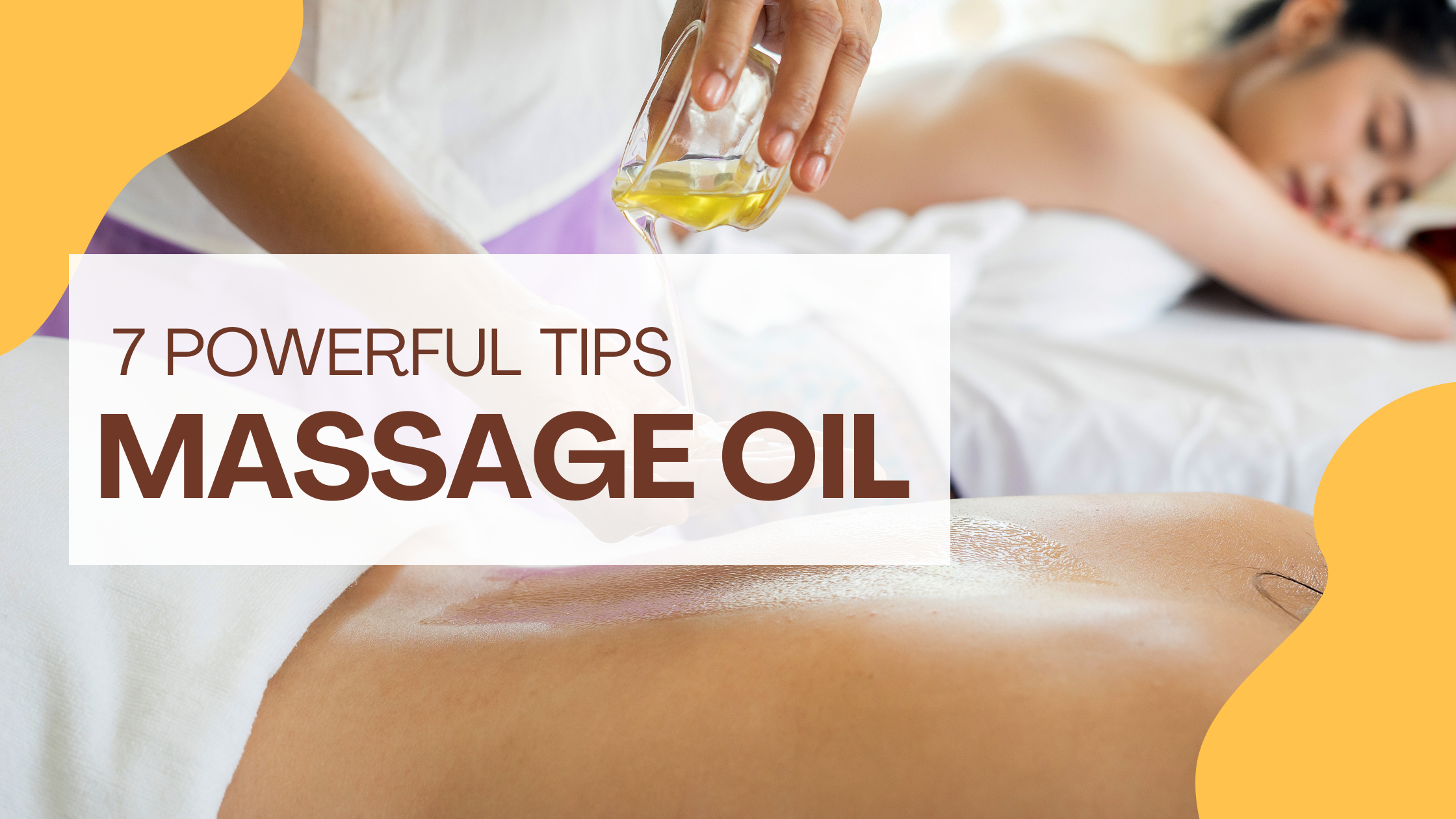1. Introduction
Imagine a moment of pure relaxation, where tension melts away, and tranquility envelops your body and mind. Massage has been practiced for centuries and is celebrated for its numerous benefits. To enhance the massage experience, the use of massage oils has become popular. In this article, we will explore the world of massage oils, their benefits, and how to choose the right one for a truly indulgent experience.

2. Understanding Massage Oils
2.1 What Is Massage Oil?
Massage oil is a lubricant specifically designed for use during massages. It allows the hands to glide smoothly over the skin, reducing friction and enhancing the overall comfort and effectiveness of the massage.
2.2 Types of Massage Oils
There are various types of massage oils available, each offering unique properties and benefits. Common types include sweet almond oil, jojoba oil, coconut oil, grapeseed oil, and olive oil. The choice of massage oil depends on personal preferences and the desired outcome of the massage.
3. Benefits of Using Massage Oil
3.1 Promotes Relaxation and Stress Relief
Using massage oil during a massage session can greatly enhance relaxation and provide stress relief. The gentle and smooth movements of the therapist’s hands, combined with the soothing properties of the oil, create a calming effect on the body and mind. The fragrance and texture of the oil further contribute to a serene and tranquil experience, allowing you to unwind and let go of built-up tension.
3.2 Nourishes and Hydrates the Skin
Massage oils are not only beneficial for the massage itself but also for the health of your skin. Many massage oils are rich in essential fatty acids, vitamins, and antioxidants that nourish and hydrate the skin. As the oil is massaged into the skin, it helps improve circulation, promoting a healthy glow and leaving your skin feeling soft, supple, and rejuvenated.
3.3 Enhances Sensual and Intimate Experiences
Massage oils are often used in intimate settings to enhance sensuality and create a romantic atmosphere. The use of scented oils, such as lavender or ylang-ylang, can stimulate the senses and heighten the experience for both partners. The smooth and silky texture of the oil adds a luxurious and intimate touch, making it a popular choice for couples looking to enhance their connection.
3.4 Soothes Aches and Pains
Massage oils can provide relief for sore muscles, aches, and pains. When applied with gentle pressure and proper massage techniques, the oil penetrates deep into the muscles, promoting relaxation and relieving tension. Some oils, like peppermint or eucalyptus oil, have analgesic and anti-inflammatory properties, further aiding in soothing muscle soreness and reducing discomfort.
You Can Try Best Massage Oil on Amazon: 
4. Factors to Consider When Choosing Massage Oil
When selecting a massage oil, it’s important to consider several factors to ensure you choose the right one for your needs. Here are some important factors to keep in your thoughts:
4.1 Scent
The scent of the massage oil can greatly influence the overall experience. Choose a fragrance that appeals to you and creates the desired ambiance. Popular scents include lavender, citrus, jasmine, and sandalwood.
4.2 Absorption Rate
Take into account the rate at which the oil is absorbed by the skin. Fast-absorbing oils are ideal if you prefer a non-greasy feeling after the massage, while slower-absorbing oils provide a longer-lasting glide.
4.3 Skin Sensitivity
If you have sensitive skin or allergies, opt for hypoallergenic massage oils or conduct a patch test before using a new oil. This will help avoid any adverse reactions or skin irritations.
4.4 Ingredients
Be mindful of the components present in the massage oil. Natural and organic oils are often preferred as they are free from harsh chemicals and additives. Look for oils with nourishing properties such as vitamin E, jojoba, or almond oil.
4.5 Texture
Consider the desired texture of the oil. Some prefer lightweight and non-greasy oils, while others enjoy a richer and more moisturizing texture. Experiment with different textures to find the one that suits your preferences.
4.6 Personal Preferences
Ultimately, your personal preferences play a significant role in choosing the right massage oil. Consider factors such as scent, texture, and the overall experience you wish to achieve.
5. Popular Types of Massage Oils
There is a wide variety of massage oils available, each with its own unique properties and benefits. Here are five popular types of massage oils:
5.1 Sweet Almond Oil
Massage therapists often opt for sweet almond oil due to its widespread popularity in the field. It has a light texture and a mild, nutty aroma. Rich in vitamin E, it nourishes and moisturizes the skin, leaving it soft and smooth.
5.2 Jojoba Oil
Jojoba oil possesses a remarkable similarity to the natural oils our skin produces, enabling effortless absorption without any greasy residue. Its hypoallergenic nature renders it suitable for all skin types. Jojoba oil also has excellent moisturizing properties.
5.3 Coconut Oil
Coconut oil is known for its pleasant tropical aroma and smooth texture. It is rich in fatty acids and has antimicrobial properties that can benefit the skin. Coconut oil solidifies at cooler temperatures but melts upon contact with the skin.
5.4 Grapeseed Oil
Grapeseed oil, known for its lightness, effortlessly permeates the skin, facilitating quick absorption. It is odorless and has a silky texture. Grapeseed oil is high in antioxidants and vitamin E, making it beneficial for promoting skin health.
5.5 Olive Oil
Olive oil, a common kitchen staple, can also be used as a massage oil. It has moisturizing properties and contains antioxidants that help protect the skin. Olive oil has a heavier texture, so it is often mixed with lighter oils for massage purposes.
6. How to Use Massage Oil Effectively
To maximize the benefits of massage oil, follow these steps for an effective and enjoyable massage experience:
6.1 Prepare the Massage Area
Create a soothing ambiance by dimming the lights, playing relaxing music, and ensuring a comfortable temperature in the room. Arrange towels, pillows, and any other props that will contribute to a cozy and inviting atmosphere.
6.2 Warm the Oil
Before applying the oil, warm it slightly to enhance its therapeutic properties. Place the bottle of oil in a bowl of warm water or use a specialized oil warmer. Test the temperature on your wrist to ensure it is comfortably warm but not hot.
6.3 Apply and Massage the Oil
Pour a small amount of oil into your palms and rub them together to warm it further. Begin by applying the oil with gentle, long strokes over the body, gradually increasing the pressure as desired. Use a combination of gliding, kneading, and circular motions to massage the muscles and release tension.
6.4 Adjust Pressure and Techniques
Communicate with the recipient of the massage to determine their comfort level regarding pressure and techniques. Some individuals prefer deep tissue massage, while others prefer a lighter touch. Tailor the massage to their needs and adjust accordingly.
6.5 Post-Massage Care
After the massage session, it’s important to provide proper post-massage care for optimal relaxation and well-being. Here are some post-massage care tips:
Encourage the recipient to take their time to rest and relax after the massage. Allow them to lie down or sit comfortably, providing a calm and quiet environment for further relaxation.
Offer a warm towel or moistened wipes for the recipient to gently wipe off any excess oil from their body. This can help them feel refreshed and comfortable.
Hydration is key. Advise the recipient to drink plenty of water after the massage to flush out toxins released during the massage and to rehydrate the body.
Suggest taking a warm bath or shower a couple of hours after the massage to further enhance relaxation and remove any remaining oil from the skin.
Recommend avoiding strenuous activities or exercise immediately following the massage to allow the body to fully relax and benefit from the effects of the treatment.
By following these post-massage care tips, the recipient can prolong the sense of relaxation and maximize the benefits of the massage.
7. DIY Massage Oil Recipes
Creating your own massage oil blends can be a fun and personalized way to enhance your massage experience. Here are three simple and delightful DIY massage oil recipes:
7.1 Calming Lavender and Chamomile Blend
Ingredients:
- 1/4 cup of sweet almond oil
- 5-7 drops of lavender essential oil
- 3-5 drops of chamomile essential oil
Mix all the ingredients together in a glass bottle or container. Shake well to ensure proper blending. This calming blend is perfect for promoting relaxation, reducing stress, and inducing a peaceful sleep.
7.2 Energizing Citrus and Ginger Infusion
Ingredients:
- 1/4 cup of jojoba oil
- 5-7 drops of sweet orange essential oil
- 3-5 drops of ginger essential oil
Combine all the ingredients in a glass bottle or container and mix thoroughly. This invigorating blend is ideal for boosting energy, revitalizing the senses, and providing a refreshing massage experience.
7.3 Sensual Rose and Ylang-Ylang Elixir
Ingredients:
- 1/4 cup of coconut oil
- 5-7 drops of rose essential oil
- 3-5 drops of ylang-ylang essential oil
Blend the ingredients together in a glass bottle or container until well combined. This romantic and sensual blend is perfect for intimate moments, enhancing connection, and creating a luxurious massage experience.
Feel free to adjust the number of essential oil drops based on your preferred strength of aroma. Remember to patch test the oil on a small area of skin to check for any potential allergies or sensitivities before using it for a full-body massage.
8. Conclusion
Massage oil plays a significant role in enhancing the overall massage experience. It provides numerous benefits, including promoting relaxation, nourishing the skin, enhancing intimacy, and soothing aches and pains. By selecting the right massage oil and using it effectively, you can enjoy a truly rejuvenating and therapeutic massage session.
When choosing a massage oil, consider factors such as scent, absorption rate, skin sensitivity, ingredients, texture, and personal preferences. Experiment with different types of massage oils to find the one that suits your needs and preferences the best. Remember to warm the oil before application and adjust the pressure and techniques during the massage to ensure a comfortable and enjoyable experience.
After the massage, provide post-massage care by allowing time for rest, offering a warm towel, encouraging hydration, and avoiding strenuous activities. These steps will help prolong the benefits of the massage and support overall well-being.
For a more personalized touch, you can also create your own massage oil blends using essential oils. Explore different combinations to suit your desired effects, whether it’s promoting relaxation, energizing the body, or creating a sensual ambiance.
Incorporating massage oil into your massage routine can transform a simple massage into a luxurious and therapeutic experience. Soothe your body, calm your mind, and indulge in the nourishing and pleasurable effects of massage oil.
9. Frequently Asked Questions (FAQs)
Can I use massage oil on all skin types?
Yes, most massage oils are suitable for all skin types. However, if you have sensitive skin or specific allergies, it’s recommended to perform a patch test before applying the oil to your entire body.
How much massage oil should I use during a session?
Begin with a modest quantity and adjust accordingly based on your requirements. It’s better to start with less and gradually increase the amount to avoid excess oiliness.
Can I use massage oil during pregnancy?
It’s best to consult with your healthcare provider before using any massage oil during pregnancy to ensure the safety of both you and your baby.
How should I store massage oil?
Store your massage oil in a cool, dark place to preserve its quality and extend its shelf life. Steer clear of direct sunlight and extreme temperatures to prevent any adverse effects.
Are there any precautions I should take when using massage oil?
Avoid contact with the eyes and any open wounds or cuts. In the event of any negative reactions or discomfort, cease usage immediately and consult with a medical professional for guidance.












